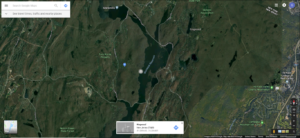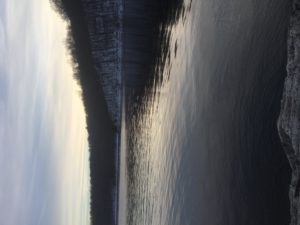As I always do when I return home, I visited my favorite spot in my hometown, which is the edge of the Wanaque Reservoir in Ringwood, New Jersey. It is a short 15 minute hike from behind my house, making it very accessible and a place where I find peace and comfort. First dug out in 1928, the reservoir is a widened part of the Wanaque River, and this contributes to the Sterling Forest watershed. Seasonally, the reservoir and its surrounding area undergoes drastic changes. In the summer, if there is a prolonged drought period, the reservoir can get very low because of evaporation and usage by surrounding towns, and you are able to walk onto parts of it that would usually be submerged. When I visited this week, this was obviously not the case after the amount of rain and snow that we got. The majority of trees are deciduous (lots of oaks, some maples) with a few pines bunched together in certain areas. Most of the trees are bare, with a few still holding onto its last couple of leaves. A couple of crows linger in the area, as well as a few squirrels looking for the last few scraps before going into hibernation. Other than that, there are no signs of any land animals remaining in the area.
As told from the perspective of 18th century philosopher Wright:
One can only marvel at such a colorful and tranquil scene. The sun shines on the clear blue water, creating millions of dazzling individual sparkles of light. Tiny, rippling waves come and go along the shoreline, making such a sound that can be compared to one’s own private little beach, where there are no worries. Crow calls can be heard from afar, signaling the approach of brisk weather, as all other birds have already migrated. Every so often one can hear the splash of a bass across the lake. A lone beaver sits on the edge of a rock near the water, absorbing the last few rays of sunlight and heat of the season. The vast trees, now bare, sway in the cool and crisp wind. There are no worries in this place. Nature is the only presence; it provides and comforts the soul. It is truly a magnificent place, and one can only marvel at and appreciate its beauty.
An Aldo Leopold compare and contrast:
A small beach in Vermont, and a lakeside woods in New Jersey. Each are beautiful in their own way. Take the marvels on Crescent Beach in Vermont. This majestic place overlooks the esteemed Lake Champlain, home to such a diverse set of aquatic life. Do not be fooled; the water is not the only thing that this place has to offer. Overgrowth occurs everywhere on the sand, with many diverse shrubs and trees making their home in a very unique place. Altogether, this creates a very unique and unlikely habitat for many species, both aquatic and land, and gives this pristine beach such a natural feel. And then the reservoir in New Jersey. Very similar indeed. The combination of the beauty of land and sea makes it very unique indeed, similarly to Crescent Beach. The woods, however, give such a wild feeling that compels one to feel almost as a part of this beautiful system. Both areas, although so individual, are so natural and admirable that one can do nothing but admire.





Recent Comments